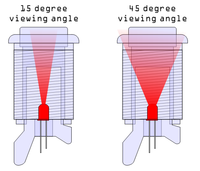Lighting Microswitch Buttons
FX Buttons (aka Translucent Happ Buttons) are the brainchild of Shawnzilla and have recently become a very popular option for people looking to light up their buttons using LEDs with GroovyGameGear's LED-Wiz and PowerMAME. Basically, they are microswitch push-buttons cast from the same mold as regular Happ buttons, but using colored translucent plastics instead of the regular opaque.
They can be bought from Shawnzilla himself at FXButtons.com or from several re-sellers such as PonyBoy, DiveMaster or GremlinSolutions (UK).
Lighting Considerations
When buying LEDs, most people will generally go by the LEDs brightness (aka luminous intensity or MCD). Brightness is important, but when you're mounting your LEDs so they're pointing straight up through the button (as in the method described below) the most important factor in choosing an LED is it's luminous flux, which is determined by it's MCD and beam angle. An accute beam angle will cause an extreme (sometimes blinding) hot-spot in the center of the button.
Luminous Flux is a good guide to how well and LED distributes light; it takes into account how bright the LED is (its luminous intensity) and how wide of an angle light is dispursed from the LED.
Here's a simple calculator to help you easily figure out what an LEDs luminous flux is:
If you have to use an LED with a viewing angle less than 45°, it is recommended that you use the 'Kneivil' method of putting two LEDs at the sides of each button.
Choosing a Resistor
While I'm at it, here's another useful calculator for determining what size resistor each LED needs: http://led.linear1.org/1led.wiz
